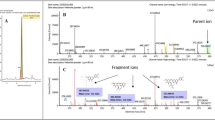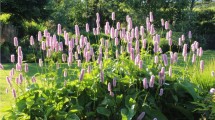Abstract
The diethyl ether and ethyl acetate fractions of the peel of the fruit of Solanum incanum. (S. incanum) were analyzed using gas chromatography-mass spectrometry (GC–MS). 105 compounds were identified in the diethyl ether fraction and 75 compounds were identified in ethyl acetate fraction. Among them, 5 compounds were analyzed by fragmentation pattern, discussed, and compared with NIST database. The antibacterial screening was also conducted for bothdiethyl ether and ethyl acetate fractions of the fruit peel of S.incanum using four pathogens, two Gram-positive bacteria Staphylococcus aureus (S. aureus) and Streptococcus pyogenes (S. pyogenes) and two Gram negative bacteria Escherichia coli (E. coli), Klebsiella pneumoniae (K. pneumonia), at various concentrations (250, 500, 750 and 1000 μg/ml). The diethyl ether and ethyl acetate fractions of the peel of S. incanum exhibited activity against E. coli and K. pneumonia at 1000 μg/ml concentration.













Similar content being viewed by others
Code availability
Chemdraw was used for drawing the Chemical structures.
References
Abebe H, Gebre T, Haile A (2014) Phytochemical investigation of the roots of Solanum incanum, Hadiaya Zone, Ethiopia. J Med Plants Stud 2(2):83–93
Alghamdi SSK(2013) Topical depilatory and method of removing hair, Patent No. 8,551,187
Asaolu MF (2003) Chemical composition and phytochemical screening of the seeds of Garcinia kola. Pak J Sci Ind Res 46(3):145–147
Auta R, Ali I (2011) Nutritional and chemical value of Solanum incanum (L) (bitter garden egg). Int J Tropical Med Pub Health 1(1):96–107
Abdalla IMF (2015) Leaves value of Solanum incanum (L) at Khartoum, North Sudan. Int J Eng Sci Innov Technol 4(1):25–28
Asha RK, Priyanga S, Hemmalakshmi S, Devaki K (2017) GC-MS analysis of the ethanolic extract of the whole plant Drosera indica L. IJPPR 9(5):685–688. https://doi.org/10.25258/phyto.v9i2.8149
Buvaneshwari PJ, Jenifer SA, Ramya D, Sharmila C, Dhamayanthi C, Selvarajan S( 2017) Preliminary phytochemical screening and GC-MS analysis of Solanum incanum L. fruits. EPRA IJRD 2(9)
Dar BK, Bhat HA, Amin S, Zargar AM, Masood A, Amin S, Malik HA, Ganie AS (2017) Evaluation of antibacterial, antifungal and phytochemical screening of Solanum Nigrum. Biochem Anal Biochem 6(1):309–320. https://doi.org/10.4172/2161-1009.1000309
Elisha IL, Botha FS, McGaw LJ, Eloff JN (2017) The antibacterial activity of extracts of nine plant species with good activity against Escherichia coli against five other bacteria and cytotoxicity of extracts. BMC Complement Altern Med 17(1):133. https://doi.org/10.1186/s12906-017-1645-z
Essien EE, Walker MT, Newby MJ, Ogunwande AI, Setzer NW, Ekunday O (2016) The floral essential oil composition and biological activity of Solanum Macranthum Dunal. Am J Essent Oil Nat Prod 4(1):36–39
Hassim N, Markom M, Anuar N, Baharum SN (2014) Solvent selection in extraction of oil and bioactive compounds from Polygonum minus. J Appl Sci 14:1440–1444. https://doi.org/10.3923/jas.2014.1440.1444
Indhumathi T, Mohandass S (2014) Efficacy of ethanolic extract of Solanum incanum fruit extract for its antimicrobial activity. Int J Curr Microbiol App Sci 3(6):939–949
Khalil AA, Rahman U, Khan RM, Sahar A, Mehmood T, Khana M (2017) Essential oil eugenol: sources, extraction techniques and nutraceutical perspectives. RSC Adv 7(52):32669–32681. https://doi.org/10.1039/C7RA04803C
Okhale SE, Ugbabe GE, Oladosu PO, Ib-rahim JA, Egharevba HO, Kunle OF, Elisha EP, Chibuike AJ, Ettah UO (2018) Chemical constituents and antimicrobial activity of the leaf essential oil of Ixora coccinea L (Rubiaceae) collected from North Central Nigeria. Int J Bioassays 7(4):5630–5637
Ravichandran YD, Sulochana N (2006a) 1H and 13C assignment of Passiflorine from Passiflora edulis. Asian J Chem 18(4):3092–3096
Ravichandran YD, Sulochana N (2006b) Isolation and characterization of 8-methylluteolin 5-O-6¢¢-(2-methyl propanoyl) glucoside and patuletin 3-o-glucuronide from Tithonia tagetiflora. Asian J Chem 18(4):3173–3175
Sheeba E (2010) Antibacterial activity of Solanum surattense burm. F KUJSET 6(1):1–4. https://doi.org/10.3126/kuset.v6i1.3278
Sundar S, Pillai YJK (2015) Phytochemical screening and gas chromatograph-mass spectrometer profiling in the leaves of Solanum incanum L. Asian J Pharm Clin Res 8(3):179–188
Sakha H, Hora R, Shrestha S, Acharya S, Dhakal D, Thapaliya S, Prajapati K (2018) Antimicrobial activity of ethanolic extract of medicinal plants against human pathogenic bacteria. T U J M 5(1):1–6. https://doi.org/10.3126/tujm.v5i0.22292
Tesfaye T, Ravichandran YD (2018) Traditional uses, pharmacological action and phytochemical analysis of Carrissa carandas Linn. Nat Prod Chem Res 6:334. https://doi.org/10.4172/2329-6836.1000334
Tamrat T, Ravichandran YD (2018) A review on anticancer activity of some plant-derived compounds and their mode of action. Nat Prod Chem Res 6:330. https://doi.org/10.4172/2329-6836.1000330
Yetayih MM, Ravichandran YD (2020) Extraction and GC-MS analysis of the essential oil from the peel of Solanum incanum and its antibacterial activity studies. Asian J Chem 32(8):2001–2006. https://doi.org/10.14233/ajchem.2020.22770
Yrjönen T(2004) Extraction and planar chromatographic separation techniques in the analysis of natural products, University of Helsinki, Helsinki, Finland, Doctoral dissertation
Acknowledgements
The authors thank the management of Wollega University and the Ministry of Science and Higher Education, Ethiopia for providing the required facilities to carry out this research work.
Funding
Funding is not available for this article.
Author information
Authors and Affiliations
Corresponding author
Ethics declarations
Ethical statement
This article does not contain any studies involving animals performed by any of the authors. This article does not contain any studies involving human participants performed by any of the authors.
Conflict of interest
Yesudass Dominic Ravichandran has no conflict of interest. Mequanint Yetayih has no conflict of interest.
Additional information
Publisher's Note
Springer Nature remains neutral with regard to jurisdictional claims in published maps and institutional affiliations.
Rights and permissions
About this article
Cite this article
Ravichandran, Y.D., Yetayih, M.M. The GC–MS analysis of the diethylether and ethylacetate fraction of the peel of Solanum incanum and the study of their antibacterial activity. ADV TRADIT MED (ADTM) 22, 809–821 (2022). https://doi.org/10.1007/s13596-021-00623-1
Received:
Accepted:
Published:
Issue Date:
DOI: https://doi.org/10.1007/s13596-021-00623-1




